| by Jennifer Donovan, director of public relations
Frank Best, a 1975 forestry alumnus and middle-school science teacher at Menominee Catholic Central, is bringing two groups of sixth, seventh and eighth grade students to Michigan Tech for a hands-on science experience on Monday and Tuesday, Sept. 13-14. On Monday, they will take a learning cruise of Portage and Torch Lake and Lake Superior on the Research Vessel Agassiz. Each group will spend two hours on Tuesday in the lab, where the students will dissect lake trout stomachs and examine the water samples they gathered under a high powered microscope. They will use a guidebook to identify the algae in their water sample. They will also study the organisms they collect from bottom samples. Using all this data, they will construct a food web of the lake. This is the fifth year that Best has brought his students to Michigan Tech. After riding on the Agassiz himself during a summer course he took at Tech on “Using Navigation to Teach Math,” he decided it would be an ideal hands-on learning experience for his students. “One of my main goals as a science and math teacher is to expose students who use math and science in their jobs,” said Best. “I want students to understand that math and science are ways of looking at our world, not just classes that you have to take in school.” The teacher said his students gain a great deal of knowledge about the Lake Superior ecosystem from their time on the Agassiz. “They also get to experience so much more than I can show them in the classroom,” he added. “They get to use state-of-the-art equipment that we can not afford at our small school.” The Agassiz will make several stops to enable the students to measure the depth, temperature and dissolved oxygen of the lakes at different depths. They will also sample the mud on the bottom of the lakes to find out what might be living down there. They will use a plankton net to capture some of the members of the plankton community. While the students are at Tech, they will also see a MSE demonstration and visit Nara Nature Park as part of a SFRES program. The Menominee students will stay at St. Anne’s church in Chassell and St. Albert the Great church in Houghton. |
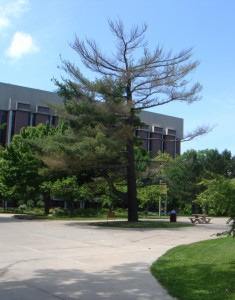
When the Leaning Tree, also called the EERC Tree, was cut down in August, the question was: which was older, the campus or the tree? The campus dates back to 1887, when Jay Hubbell donated land for the Michigan College of Mines; it turns out the tree is older by sixteen years, says Mike Hyslop, GIS analyst and a doctoral student in forest science, SFRES.
Recall that Facilities cut a slab, called a “cookie,” for Hyslop, so he could determine how old the tree was by counting the rings. Each annual ring is composed of two parts–“early” and “late” wood–with different color and structural characteristics.
By Hyslop’s count, it is likely that the Leaning Tree, a white pine, took root–Hyslop says “was established”–in 1871.
This is dendrochronology: the dating of wood. Trees add both height and diameter annually. The radial growth exhibits patterns that vary primarily according to precipitation and temperature, but also light availability and disturbance.
Typically, warm temperatures and plentiful precipitation produce wider rings; and cooler, drier conditions produce narrower rings. Missing rings occur in “high ecological stress” years, when the tree does not have the resources to put on radial growth.
To age the Leaning Tree, Hyslop sanded the slab because chain saw blades produce a fairly rough surface, and the rings are difficult to discern, especially when there are several small-growth years in a row and the rings are closely spaced.
To date the tree back to 1871, Hyslop counted the rings twice by hand, under magnification, and came up with the same result. He will do some additional sanding and recheck his findings.
“I am reasonably confident,” he says, “that the 139 years is correct, but there are a few areas of densely-packed rings that bear closer scrutiny.”
The tree, then, was witness to the entire history of the institution to date. Hubbell donated the land, the site for the first campus building, Hubbell Hall, on Aug. 26, 1887. The local newspaper, in a modest story, announced the donation five days later, on Sept. 1, under a small headline reading “Our Mining School.” It read, in part, “This site seems to us to be in every way adapted for the Mining School. The drainage is perfect, it will be in a pleasant neighborhood, with fine views up and down the lake, and of the opposite shore. There are numerous other sites in town which could have been obtained, but it seems to us that the committee [Board of Control], in deciding to accept the one presented by Mr. Hubbell, have acted wisely, and that the people will be fully satisfied.”
The tree outlived the Hubbell building, which was demolished in 1970, by 40 years.
Another white pine will be planted in its space. The history it will witness? Only time will tell
| by Alanna Knapp, student editor
Professor Blair Orr (SFRES) has received the 2010 Distinguished Teaching Award in the associate professor/professor category. He is singled out especially for directing Tech’s Peace Corps Master’s International Program, which allows students to combine two years of Peace Corps service with a graduate degree program. Involving eight disciplines, Michigan Tech has the largest number of Master’s International programs nationwide at one university. Orr earned a PhD in Forestry Economics from the University of Wisconsin-Madison and came to Michigan Tech in 1992. From the start, he taught economics and began the University’s first Master’s International program, forestry, in 1995. He became the director all eight programs in 2006. 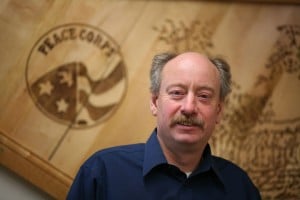 “Blair brings to the University his creativity, his time, a passion for international programs, and, most importantly, a commitment to students’ success,” said Dean Margaret Gale. Students returning from the field tell Gale that they are well-prepared for their service. “They are confident,” she said, “and, with Blair’s guidance and influence, prepared for service abroad.” Less than three percent of Michigan Tech students leave the program, compared to one-third nationally. Gale attributes that commitment to Orr’s dedication. Students say that success in the field begins in Orr’s classroom. “He prepares students to deal with the challenges of life in a developing country,” one student said. “He exposes them to the main issues they will encounter–teaching them to critically examine issues, and helping them develop the ability to find more information about these issues when the need arises overseas.” Another student surmises that Orr is “possibly the best Peace Corps Master’s International director in the country.” Other students describe him as “an excellent teacher who is both knowledgeable and able to effectively transfer this knowledge to his students. He uses homework methods that make students connect their lives to what is being learned in class.” For his part, Orr says that the course material for these master’s students is more than just interesting information. “The success in the class and abroad,” he says, “depends upon students’ ability to understand and assimilate these lectures and readings in the field.” Therefore, he emphasizes, in part, class participation in discussions and writing. “I require students to keep a journal. When they write about the course topics–dealing with politics, corruption, community involvement–it helps to assess their comprehension.” Directing such an endeavor engages him. “I am involved from the moment they apply to the program until graduation,” he says. Sometimes their lives are arduous. He has one student who has to travel 20 miles to access the Internet. What he enjoys most is interacting with these students in the field. “Some days they are excited and enjoying the work,” he said, “and the next day they are depressed and need encouragement.” This understanding coach and mentor concludes, “Because I served as a Peace Corp volunteer, I am able to identify with their experiences.” |
 July 1, 2010—By Jennifer Donovan
July 1, 2010—By Jennifer Donovan
Most people today embrace sustainability as a good thing, and it may be the greatest technological challenge our society has ever faced.
But, in a paper just published in the journal BioScience, Michigan Technological University wildlife ecologist John A. Vucetich and Michigan State University environmental ethicist Michael Nelson say that the technological challenge of sustainability pales in comparison to the ethical crisis it presents to society.
In a paper titled “Sustainability: Virtuous or Vulgar?” Vucetich and Nelson examine the most widely-accepted definitions of sustainability, which indicate at least roughly that sustainability is: meeting human needs in a socially-just manner without depriving ecosystems of their health. While the definition sounds quite specific, it could mean anything from “exploit as much as desired without infringing on the future ability to exploit as much as desired” to “exploit as little as necessary to maintain a meaningful life,” the scientist and ethicist say.
“From a single definition arise two wildly disparate views of a sustainable world,” says Vucetich, who teaches in Michigan Tech’s School of Forest Resources and Environmental Science and leads a long-running study of the wolves and moose of Isle Royale National Park. “Handling these disparate views is the inescapable ethical crisis of sustainability.”
“The crisis results from not knowing what we mean by value-laden terms like ‘ecosystem health’ and ‘human needs.’” Nelson says, “In other words, is ecosystem health defined only by its ability to meet human needs, or does ecosystem health define the limits of human need?”
Solving the dilemma boils down to knowing the extent to which sustainability is motivated by concern for nature. Or as Vucetich puts it: “Are we concerned for nature because nature is intrinsically valuable, or only because of what nature can do for us?”
Nelson adds, “These questions are as difficult to answer as it is necessary to answer them. We are unlikely to achieve sustainability without knowing what it means.”
More disturbingly, Vucetich and Nelson point out that almost no effort is spent trying to answer this question. For example, universities have hired dozens of academics in recent years to solve sustainability problems. None of these academics work on the ethical crisis of sustainability. Likewise, the National Science Foundation’s interdisciplinary funding program for sustainability research makes no reference to ethics, and the word “ethic” appears in only one of the titles, abstracts or keywords of the 119 projects funded so far.
Vucetich and Nelson do not advance a particular interpretation of sustainability. Rather they show us why it is so important that all segments of society–academics and the general public, the public and private sectors–confront the inescapable dilemma that sustainability represents.
“The first goal ought to be a citizenry that has enough ethical knowledge to be able to just talk about these issues intelligently,” Vucetich says. Nelson goes on to say “This is unlikely to happen until social leaders, including academics from all disciplines develop for themselves enough ethical knowledge to be able to teach the broader public how to approach these questions. Then, hopefully, answers will emerge.”
They conclude, “If we attain sustainability, it will not only require critical changes in technology, but also the most profound shift in ethical thought witnessed in the last four centuries.”
The National Science Foundation provided support for the research on which this article is based.
Michigan Technological University (mtu.edu) is a leading public research university developing new technologies and preparing students to create the future for a prosperous and sustainable world. Michigan Tech offers more than 130 undergraduate and graduate degree programs in engineering; forest resources; computing; technology; business; economics; natural, physical and environmental sciences; arts; humanities; and social sciences.
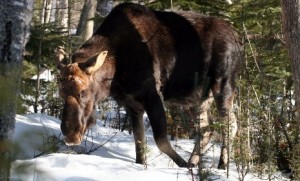
July 7, 2010—By Jennifer Donovan
As a 150-pound person ages, the aches and pains of osteoarthritis—a degenerative and progressively crippling joint disease—often become an unpleasant fact of life. Think how the same condition hurts a 1,000-pound moose.
In a report just published in Ecology Letters online, Michigan Technological University wildlife ecologists Rolf O. Peterson and John A.Vucetich; Thomas Drummer a professor of mathematics at Michigan Tech; and colleagues in Minnesota and Ohio describe a link between malnutrition early in a moose’s life and osteoarthritis as the animal ages.
“I’ve long thought that there was a nutritional link to the increase in osteoarthritis in moose on Isle Royale—a wilderness island national park in northwestern Lake Superior—as the population of the animals grew in the 1960s and 1970s,” says Peterson, who hold the Robbins Chair in Sustainable Management of the Environment. He even hypothesized this nutritional link in a paper published in the Journal of Wildlife Diseases in 1988, a paper that the scientist says was largely ignored.
Three generations of wildlife ecologists have been studying the moose of Isle Royale and their primary predators, wolves, for more than 50 years. A key factor in the study has been the discovery and analysis of the bones of moose that die on Isle Royale.
During the first two decades of the study, the scientists found increasing evidence of osteoarthritis in moose bones on Isle Royale, mostly in the animals’ hip joints and lower spine. This type of arthritis is identical to the kind that affects humans and many other mammals.
Unlike the damaged and partial skeletons usually recovered from archeological digs, the bones of moose that die in the wilderness setting of Isle Royale usually reveal details such as gender, age and degree of osteoarthritis. And they often include metatarsal leg bones, which are extremely sensitive to prenatal nutrition.
“After birth, the mass of a moose increases 30-fold, but when a moose is born, the metatarsus is already half grown,” Peterson explains. That gives them a leg up for running fast to escape their predators, the wolves.
Matching the length of a moose’s metatarsal bone with the degree of osteoarthritis found in the hip joints and spine provided Peterson and his team with their best evidence of a nutritional link to osteoarthritis.
They found that the moose with the shortest metatarsal bones—indicating poor early nutrition—were the ones more likely to develop osteoarthritis later in their lives. They also learned that during the years when the moose were most numerous coincided with the highest observed rates of osteoarthritis in moose born during that time. As the moose population declined, improving the availability of adequate nutrition, osteoarthritis declined among the better-nourished moose as they aged.
“This physiological association also has ecological implications,” Peterson wrote. “The debilitating effects of osteoarthritis would inhibit a moose’s ability to kick or dodge a lunging wolf. Consequently, the incidence of osteoarthritis is associated with the rate at which wolves kill moose on Isle Royale.”
The ecologists’ findings on osteoarthritis in the moose of Isle Royale have implications for understanding arthritis in humans, Peterson went on to say. Studies of humans and other animals have increasingly linked many chronic adult diseases with nutritional deficiencies early in life. “Our study suggests the need to consider more carefully whether osteoarthritis is like other late-onset pathologies, including heart disease, diabetes and hypertension, that appear to have risk factors established early in life,” he said. “The apparent link between early nutrition and osteoarthritis indicates that the cause of osteoarthritis is more complex than commonly assumed.”
This research was supported by the National Science Foundation, the National Park Service and Earthwatch, Inc.
Michigan Technological University (mtu.edu) is a leading public research university developing new technologies and preparing students to create the future for a prosperous and sustainable world. Michigan Tech offers more than 130 undergraduate and graduate degree programs in engineering; forest resources; computing; technology; business; economics; natural, physical and environmental sciences; arts; humanities; and social sciences.
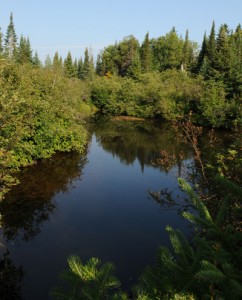 During my days at da Tech, I had my own “secret spot” down on the Otter River. I can close my eyes and visit it still, even after 53 years.Here’s an excerpt from my book, Stops Along the Way, which I wrote several years ago describing it:
During my days at da Tech, I had my own “secret spot” down on the Otter River. I can close my eyes and visit it still, even after 53 years.Here’s an excerpt from my book, Stops Along the Way, which I wrote several years ago describing it:
The Otter River is best described as a happy little stream. Its rapids didn’t roar, they cheerfully chortled. It didn’t resonate with power; it just hummed a pleasant tune. No need for mountain leveling heroics here, the Otter fit comfortably on the land. A little sun-warmed gravel bar here, a cool, shady stretch through the tag alders, a long, melodious riffle where it carved around the base of a balsam covered ridge.
Then there was the color of the water. The beer commercials would have you believe that Upper Michigan was part of the “land of sky-blue waters,” The Otter River was not blue. In the slower, deeper pools, it was the color of the clearest, finest tea you could imagine. Indeed, it was tea, steeped in the countless bogs that were the source of its waters. But it had clarity, without any trace of opacity. On the shallow riffles, where the water was tossed and aerated, it took on a distinct golden hue.
The Otter was almost a textbook trout stream. It had deep runs that held brook trout. There were deep, still pools with lots of woody debris where the big brown trout lay. The riffles held lively rainbow that rocketed skyward as soon as they felt the sting of the hook.
One weekend I looked ahead to where a sandbar stood high and dry, part way across the river. Even from a distance, it was obvious there were boot tracks crossing the bar. My heart sank; there was a trespasser in Eden. As I waded up to the bar, I cursed the gods for allowing this injustice. When I got there, I was pleasantly surprised. The tread pattern of the boots that made the tracks was clearly visible in a few locations, and I realized the tracks were mine made the week before. The world was right once more.
Ron Sadler
Forestry ’57
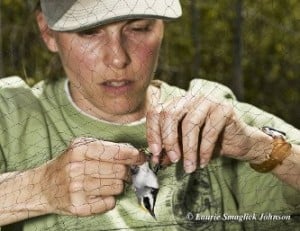
Conservation could be Amber Roth’s middle name. She loves anything to do with nature. Birds, trees, grasses, ecosystems: she’s fascinated by it all.
So after tucking a BS in Conservation Biology and International Relations and an MS in Wildlife Ecology under her belt, the Green Bay, Wisconsin, native came to Tech to earn a PhD in Forest Science.
Roth researches how to manage aspen forests to produce the maximum amount of biomass per acre without harming wildlife habitat. But she was raised by a devoted bird-watcher, and a tiny songbird that is facing hard times has also captured her heart. She has become an active member of the Golden-winged Warbler Working Group, an international conservation organization that spans two continents.
Weighing only nine grams (equal to four dimes), the golden-winged warbler flies thousands of miles twice a year, migrating from its breeding grounds in the northern Midwest to its winter home in Central and South America. The tiny bird makes the long migration six to ten times in its lifetime.
“Its fuel efficiency is the equivalent of several hundred thousand miles per gallon,” Roth says with a smile.
But the far-flying warbler is in trouble. There used to be as many as half a million of the birds, and now there are fewer than two hundred thousand. “Its numbers are declining sharply, and we don’t know why. We don’t know where the patient is bleeding,” says Roth.
The Golden-winged Warbler Working Group received a small grant from the US Fish and Wildlife Service to try to determine what’s happening. Their research is a collaborative effort involving American, Canadian, and Latin American scientists.
They are spread thin. Some of the researchers are examining the bird’s, since they often crossbreed with blue-winged warblers. Only one genetically pure population has been found so far, in Manitoba. Others are studying the biochemical signature in the warbler’s feathers, which reveal where the young birds go after their first migration. And a third group is working to connect where the birds winter in Central and South America to where they breed.
“It’s a real skin-and-bones project,” says Roth. Michigan Tech has helped out by contributing twenty-one mist nets, used to safely capture birds for study before releasing them. And Roth helped the Natural Resources Foundation of Wisconsin raise $520 by leading field trips to her research sites in Wisconsin. The foundation donated the funds to the international warbler research group in late 2009.
Like most of the other things she’s ever done, Roth says her work with the Golden-winged Warbler Working Group is helping prepare her for her dream career. With work experience in the Wisconsin Department of Natural Resources and her PhD from Michigan Tech, she’s looking forward to climbing what she calls her “career triangle”: research, education, and conservation management. “I like being involved in all three,” she says, “the research, the outreach, and the management on the ground.
Bob Sajdak, 79, a former faculty member of the school, passed away June 10, 2010. Bob was a 1959 alumnus of Michigan Tech’s forestry program.
Dean Peg Gale said, “For those of us who had Bob as a teacher, he was an amazing person. He taught dendrology, genetics and tree improvement courses, and because of his high expecta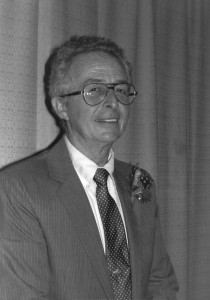 tions of students (especially in dendrology), he was fondly nicknamed ‘Black Bob.’ He often had a sly smile on his face when students were trying to negotiate grades or just joking with him on field trips. He was one of the first faculty to receive outside funds for his work in herbicides and tree production.”
tions of students (especially in dendrology), he was fondly nicknamed ‘Black Bob.’ He often had a sly smile on his face when students were trying to negotiate grades or just joking with him on field trips. He was one of the first faculty to receive outside funds for his work in herbicides and tree production.”
Bob was born in Bayfield County, Wis. on July 20, 1930, the youngest of nine children.
On November 4, 1950, he married Betty Boness of Milwaukee. They moved to Alaska where he served in the Army for several years.
In 1956, Bob returned to attend the College of Mining and Technology (Michigan Tech), the first from his family to go to college. He graduated in 1959 and worked as a U.S. Forest Service Ranger in Minnesota and as a forester for the State of Wisconsin. In 1962, Bob was hired as an instructor at Michigan Tech and in 1986, he retired as an Associate Professor of Forestry.
Bob enjoyed being a woodlot owner and working on numerous projects associated with the land.
He leaves behind his wife, Betty, and two sons, Pete and Paul. The 1973 Forester yearbook was dedicated toBob. See the pictures and story on pages 7-8 at forest.mtu.edu/yearbook/1973.pdf
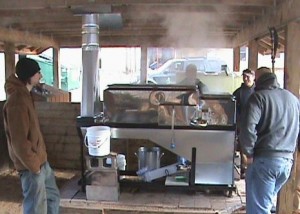
Motivate Michigan’s corporate, nonprofit and media partners contributed more than $48,000 to provide scholarships to the students with the top 10 innovative ideas for a better Michigan.
Michigan has more sugar maples than Quebec, which currently produces 70 percent of the maple syrup made in North America, and Michigan’s trees are of better quality, Kossak notes. “We could be producing more maple syrup than Quebec or Vermont—the top US producer,” he claims. “We could also become the production center for equipment used by the maple syrup manufacturers. This could be big for Michigan.”
Kossak, who plays on the offensive line for Michigan Tech’s football team, has always had a taste for maple syrup. He especially likes to eat it on ice cream. He got interested in its production when he joined Tech’s Forestry and Environmental Resource Management (FERM) enterprise program, which provides hands-on experiences for undergraduates in applied ecology and forestry. One of FERM’s projects is a small-scale maple syrup production operation, along with a series of workshops and field trips for K-12 students.
Mike Ross, a Rudyard, Mich.-based maple syrup wholesale bulk producer and equipment salesman, sold FERM some equipment for their maple syrup project, and he and Kossak started talking. “In seven minutes, I had three pages of notes,” Kossak recalls.
He also had the beginnings of a provocative idea for helping Michigan turn its economy around. When Motivate Michigan put out a call for college students to submit their innovative ideas for improving their state, Kossak was quick to propose his maple syrup solution.
It quickly made the top 10 of 280 ideas submitted, and in a public online vote that followed, Kossak moved up into the top five. He and the four other finalists were invited to Livonia to make a personal presentation before Motivate Michigan judges on May 24.
“Only one-hundredth of one percent of the sugar maples in Michigan are tapped,” he points out. Quebec taps 34 percent of its trees. “We could be producing 280 million gallons of maple syrup a year in Michigan.”
There are obstacles to that sweet future, of course, including access to land and a need for tax credits to enable large-scale development. But Kossak is convinced that these hurdles can be overcome.
As a forestry major at Michigan Tech, he is focusing on sustainable business and marketing aspects of forestry. He is also working to earn a certificate in industrial forestry. Kossak hails from Columbiaville, Mich., where he attended the Lapeer County Schools.
If his maple syrup dreams materialize, he’s hoping to work with Michigan Tech to develop a larger Sugarbush program and to consider offering a certificate in maple syrup production.
Michigan Technological University (mtu.edu) is a leading public research university developing new technologies and preparing students to create the future for a prosperous and sustainable world. Michigan Tech offers more than 130 undergraduate and graduate degree programs in engineering; forest resources; computing; technology; business; economics; natural, physical and environmental sciences; arts; humanities; and social sciences.